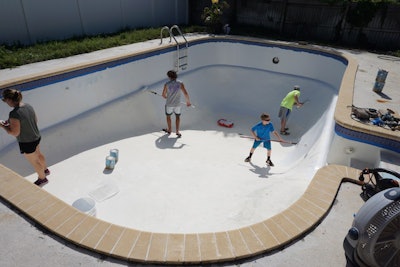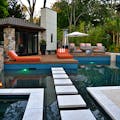
Painting a pool can be a scary and overwhelming task. But if you follow a few simple rules, and use a quality coating, you will succeed. We have a mantra at RAMUC Pool Specialty Coatings Systems about the essentials. There are three imperatives that cannot be compromised and they all involve preparation before you paint. What are the three magic words, you ask?
- Sound
- Clean
- Dry

CLEAN refers to the absence of debris, dirt, oils and contaminants. The surface must be thoroughly cleaned and etched before applying a coating. Etching helps the coating to “bite” or adhere. To clean, scrub the entire pool surface with TSP solution. Next, etch with muriatic acid then thoroughly flush with TSP and water. For optimum results, replace the aforementioned three-step process by using RAMUC’s one-step product, Clean & Prep Solution.
DRY refers to the absence of moisture. A surface that has been saturated must dry before a coating will adhere. Avoid painting when rain is eminent. The type of coating you will be using dictates how dry the surface must be before you begin. Acrylic paint can be applied to a damp surface, but epoxy must be applied to a completely dry surface.
Choice of paint is an important consideration. If your pool surface is already painted, determine what type of paint is in use. Consult RAMUC Technical Support if you are unsure and our lab technicians will assist with analysis.
Three types of coatings are suitable for aquatic surfaces:

- Rubber Based offers excellent performance, durability, chemical resistance and color retention. Formulated to provide excellent hiding and superior coverage rates. Easy to apply. Excellent for pools, fountains and ponds. When properly applied, the finish can last up to three years.
- Epoxy creates a tough, durable finish with unsurpassed stain, chemical and abrasion resistance. If the pool is currently painted with epoxy paint, you must continue to use epoxy. Epoxy can be an excellent alternative to re-plastering; two coats of a high build epoxy will achieve a hard, abrasion stain-resistant surface that costs less than resurfacing. With proper preparation, the epoxy finish can last up to eight years.
Now you are ready to paint. Using a 3/8-inch nap roller, sprayer or brush, begin painting the walls, then the deep end of the floor, and work toward the shallow end, exiting at the stairs or ladder. Be sure to apply the paint according to the recommendations on the product label. Paint applied too thin or too thick may cause undesirable results.
Once your paint project is complete, you may be eager to re-fill your pool, but allowing for adequate drying time is your last step in proper application. Waiting adequate time will provide the best results. Fill the pool using a constant, steady stream of water. Routinely monitor the water chemistry to keep the finish looking vibrant and new. Now the pool is ready to be enjoyed.













































